It’s the final week of the 2020-2021 school year here in Pittsburgh, where the public school district kept almost all its students in full-time distance learning for slightly more than one calendar year during the COVID-19 pandemic. That was followed by a phased reopening in April and May 2021, using a hybrid model in which some students attend school on Mondays and Tuesdays, others attend on Thursdays and Fridays, and the whole class is logging into the video meeting every day whether they’re at school or at home.
 Our family opted to keep our kids out of their school buildings for the rest of this school year. That’s mainly to protect their health and leave more space for social distancing of the students who really need in-person school, either because they’re struggling academically or because their parents need to go to work in person so there’s nobody to supervise them at home. It isn’t easy having the kids home all the time, but we are able to do it.
Our family opted to keep our kids out of their school buildings for the rest of this school year. That’s mainly to protect their health and leave more space for social distancing of the students who really need in-person school, either because they’re struggling academically or because their parents need to go to work in person so there’s nobody to supervise them at home. It isn’t easy having the kids home all the time, but we are able to do it.
Also, we think the hybrid model is kind of the worst of both worlds: All the hassle of getting kids out of the house on time, fully dressed, carrying everything they’ll need for the day–but only two days a week, so instead of a consistent daily routine you have to remember which days to do that–and you also have to do distance learning three days a week! It’s easier to do just one thing. (We are beyond impressed with the teachers who have managed to keep up with teaching in person and in a video meeting at the same time, which is just ridiculous, but they’re doing it somehow!)
Distance education is good enough for these two kids because they are staying on track or ahead of their grade levels. This is our family’s experience and is not meant to prove that nobody will have academic setbacks because of school closures, just that not everybody will.
We always suspected that they did a lot of their learning outside of school, and we saw just how true that is in the six weeks of spring 2020 when they abruptly had no school at all. After distance learning began, we continued the supplemental activities that build smarter kids and watched our kids continue to learn and change and grow!
Nicholas has excellent grades in challenging classes, seems to be learning about as much as he did in any year of in-person school, and is diligently completing assignments and extra-credit work with very little parental supervision. Although he seems to spend most of the rest of his time watching videos, that’s not just mindless entertainment–he learns about lots of interesting things, like exactly why millions of potatoes went to waste early in the pandemic; he picks up science experiments, computer skills, and cooking techniques that he wants to try in real life; he kept up with the fast-moving political and pandemic news of 2020 and had a lot of interesting conversations with us. And since he turned 16, I’ve been teaching him to drive!
Lydia has needed a lot more parental attention than Nicholas, so this article is mostly about the abundant evidence that Lydia has learned a lot despite social distancing and will be ready for second grade this fall! Yes, we do hope that next school year will be fully in-person and “back to normal,” but her unusual kindergarten-and-first-grade experience hasn’t hurt her.
But! What about socialization??
It seems that a lot of Americans who did only the minimum social distancing required by local rules more lenient than ours, are under the impression that we’ve literally been indoors every minute for a whole year. Also, they seem to think that children can be together only in school or that people can’t possibly interact without seeing each other’s mouths. This is all very strange.
We never were forbidden to go outside! We went out into our own yard almost every day, and Lydia took a walk with a parent at least once a week. It’s true that the playgrounds were closed for three months, but other parts of the parks were open, and we were hiking even in the worst of times. It’s true that Lydia didn’t play with another child (except her much-older brother) for two months, but she had outdoor conversations with several adult neighbors. That’s socializing!
 Like most people older than herself, Lydia had the experience of attending video meetings while dressed appropriately on top and wearing pajama pants! Here you see her on Halloween, attending distance learning in her cheetah costume (my mother made her this wonderful cheetah hood with built-in pandemic mask!) and getting to see her classmates’ Halloween costumes onscreen.
Like most people older than herself, Lydia had the experience of attending video meetings while dressed appropriately on top and wearing pajama pants! Here you see her on Halloween, attending distance learning in her cheetah costume (my mother made her this wonderful cheetah hood with built-in pandemic mask!) and getting to see her classmates’ Halloween costumes onscreen.
Except during the peaks of viral spread, Lydia and her best friend from kindergarten–who used to go from school to a playground together almost every day–have been able to play together outdoors about once a week. She’s also played with kids who live near us and kids she meets at playgrounds. Wearing masks and trying to stay six feet apart didn’t crimp their style all that much–it was still fun! Lydia has been really good at remembering the rules that began with, “Don’t touch your face until you get home and wash your hands,” in early March 2020. We’re letting those rules relax slowly as things get safer, continuing to wear masks even outdoors when the people around us are masked. Being a little more careful than might be necessary doesn’t hurt us.
I do think that Lydia’s willingness to sit still, be quiet, and follow directions has slipped dramatically during distance learning, and that one reason for this is that she’s not in the social environment of school, where misbehavior feels more obvious because you’re surrounded by people your age who are behaving mostly properly and will show their disapproval if you don’t. Seeing her get along well with other kids in person shows me she hasn’t lost all social skills! I hope that when she goes back to school, the environment will guide her behavior kind of automatically and she won’t have to be retrained from scratch!
Despite her opposition to behaving properly in class or diligently completing written assignments, Lydia did form a bond with her main classroom teacher and was very excited to send her a valentine in the mail–and even more excited to see the valentine in her teacher’s hands on the computer screen a few days later!
Meanwhile, here are some highlights of what she’s been learning….
Math
 Distance learning for kindergartners in May-June 2020 took the form of paper packets issued every two weeks that were the same for every kindergartner in Pittsburgh Public Schools. The math section was far simpler than what Lydia had been doing in her weekly homework, so she’d breeze through two weeks’ math in about two days, and then we’d give her something to do at math time each day.
Distance learning for kindergartners in May-June 2020 took the form of paper packets issued every two weeks that were the same for every kindergartner in Pittsburgh Public Schools. The math section was far simpler than what Lydia had been doing in her weekly homework, so she’d breeze through two weeks’ math in about two days, and then we’d give her something to do at math time each day.
The homemade worksheet shown here was completed in less than 30 minutes. You can see why we were unconcerned about her readiness for first grade math! (Lydia solved all the problems herself, but she got tired of writing, so she told me what to write for the last few.)
I was a little concerned about her tendency to write numbers or letters mirror-reversed sometimes . . . but I knew that this is common at her age and usually self-correcting . . . and over the course of first grade, I’ve seen her slowly getting better at it, even though she isn’t writing by hand as much as she would in in-person school.
This school year has involved more video meetings (five hours a day!) and on-screen work than handwritten work, but often Lydia resists writing as much or as neatly as she’d be expected to do if her teacher were collecting her work.
 However, she does practice writing when she decides to write something! A few months into first grade, Lydia decided that since she already knew the math her class was practicing, she was ready to teach it. She made three copies of a textbook called Math! Yes! and held classes for her beloved cubs. They are quick learners like their mother.
However, she does practice writing when she decides to write something! A few months into first grade, Lydia decided that since she already knew the math her class was practicing, she was ready to teach it. She made three copies of a textbook called Math! Yes! and held classes for her beloved cubs. They are quick learners like their mother.
Lydia practiced measurement skills, as well as arithmetic, in the Animal Flying Competition. She repeatedly played this game, in which she dragged dozens of stuffed animals into our master bedroom, divided them into teams by species, and had them take flying leaps off the bed. At first she was gauging their achievement by taking all the pillows off our bed, lining them up on the floor, and recording which one (by pillowcase pattern) each animal reached–but I objected to my pillows being on the floor and got her the measuring tape. Then she was not only practicing the physical skill of getting the tape straight to measure fairly, but also writing down the number of inches in each animal’s jump and adding up the total score for the team. Somehow, the Magical Cheetah Team always won….
We also calculated the midpoint of Time, but actually I did all the arithmetic there, while Lydia did most of the creative thinking!
Reading and Writing
Our greatest encouragement in this subject area is that Lydia routinely reads signs, labels, the spines of DVDs in the drawer, and other such practical things, demonstrating that she’s able to recognize all of the words taught in school so far and many more! She seems to be reading on a second- or third-grade level.
Distance learning, in the format they’ve used here, doesn’t allow for reading groups in which students work with a few others on their level; the whole class has to work together all the time. But even though the class was on a level that was easy for Lydia, practicing her reading and spelling of simple words improved her skills! English spelling is tricky!

 Despite her resistance to writing on assigned topics, Lydia has demonstrated good understanding of how to structure a written document when she feels like it. About a year ago, she was inspired all on her own to write these instructions for cooking rhubarb the magical cheetah way! She asked for adult help with the writing but took full responsibility for figuring out how to spell, “Instructions complete!” While not correct, her spelling shows a clear understanding of phonics….
Despite her resistance to writing on assigned topics, Lydia has demonstrated good understanding of how to structure a written document when she feels like it. About a year ago, she was inspired all on her own to write these instructions for cooking rhubarb the magical cheetah way! She asked for adult help with the writing but took full responsibility for figuring out how to spell, “Instructions complete!” While not correct, her spelling shows a clear understanding of phonics….
This break from commuting to school allows time for a new tradition, Morning Story: I read aloud to Lydia, usually one chapter of a book, while drinking my first cup of coffee. We both enjoy it and have shared many good books that Lydia isn’t yet able to read to herself but is able to understand–read about some of them here and here and here!

 Recently, our second-grade neighbor introduced Lydia to a series of books about warrior cats!!! And then we got together with a fourth-grade friend who is also into these books! Lydia had a great time playing warrior cats with each of them, and each loaned her a book to read. Lydia is not able to read these books fluently enough to really enjoy them, but that hasn’t stopped her from planning to write her own! Meanwhile, I’m reading them aloud to her. They’re not my favorite kind of story, but they are well written and very inspiring to Lydia.
Recently, our second-grade neighbor introduced Lydia to a series of books about warrior cats!!! And then we got together with a fourth-grade friend who is also into these books! Lydia had a great time playing warrior cats with each of them, and each loaned her a book to read. Lydia is not able to read these books fluently enough to really enjoy them, but that hasn’t stopped her from planning to write her own! Meanwhile, I’m reading them aloud to her. They’re not my favorite kind of story, but they are well written and very inspiring to Lydia.
Science and Such
 The kindergarten distance-learning packets, and the first-grade “choice boards” for days or half-days without video meetings, included some outdoor activities Lydia loved: Earth Day hike! Identify different kinds of trees! Count how many birds, bugs, and squirrels you see just walking around the block! It’s easy to revive these activities at times when she’s not doing them for school, just to make an outing more interesting.
The kindergarten distance-learning packets, and the first-grade “choice boards” for days or half-days without video meetings, included some outdoor activities Lydia loved: Earth Day hike! Identify different kinds of trees! Count how many birds, bugs, and squirrels you see just walking around the block! It’s easy to revive these activities at times when she’s not doing them for school, just to make an outing more interesting.
“Make a bird feeder out of things you have around the house,” was a great assignment to have on a day when I had cleaned out the freezer and found several bags of breadcrumbs that were several years old! We understand that bread is not the healthiest food for birds, but an occasional serving won’t hurt them. We pulled an empty plastic bottle from the recycling bin, I bravely cut it with a utility knife, and Lydia decorated it and filled it with breadcrumbs. We learned months later that we weren’t the only ones excited to see birds eating there–several neighbors, at different times, told us that checking out our bird feeder as they passed had brightened their days! We kept it going until winter.
 Lydia’s Girl Scout leader also inspired two rounds of scientific experimentation! After canceling in-person meetings for the duration of the pandemic and holding one outdoor event in September, the troop began meeting by video chat every two weeks–but to Lydia, most of these meetings just felt like more online school. Then her leader did a no-contact drop-off of materials for some projects they’d do “together,” and one of these was making a fire-starter by filling a paper coffee filter with some dried foods that both burn well and smell nice. I don’t know how well it works to start a fire (Lydia and her dad plan to try it when they go camping this summer) but Lydia was entranced by the cinnamon sticks and dried orange slices! She had some left over and asked how the cinnamon sticks related to the familiar powdered cinnamon. “Wow, cinnamon is ground-up tree bark?! So could I actually make my own cinnamon from these sticks?” We got out the mortar and pestle, and after much effort she converted it into coarse, sharp grit, but she was pleased to chew on it and felt a great sense of accomplishment.
Lydia’s Girl Scout leader also inspired two rounds of scientific experimentation! After canceling in-person meetings for the duration of the pandemic and holding one outdoor event in September, the troop began meeting by video chat every two weeks–but to Lydia, most of these meetings just felt like more online school. Then her leader did a no-contact drop-off of materials for some projects they’d do “together,” and one of these was making a fire-starter by filling a paper coffee filter with some dried foods that both burn well and smell nice. I don’t know how well it works to start a fire (Lydia and her dad plan to try it when they go camping this summer) but Lydia was entranced by the cinnamon sticks and dried orange slices! She had some left over and asked how the cinnamon sticks related to the familiar powdered cinnamon. “Wow, cinnamon is ground-up tree bark?! So could I actually make my own cinnamon from these sticks?” We got out the mortar and pestle, and after much effort she converted it into coarse, sharp grit, but she was pleased to chew on it and felt a great sense of accomplishment.
About six months later, I got some free cinnamon sticks through our local Buy Nothing group, and Lydia was excited to do another round of grinding. Cheap entertainment and good exercise!
Music
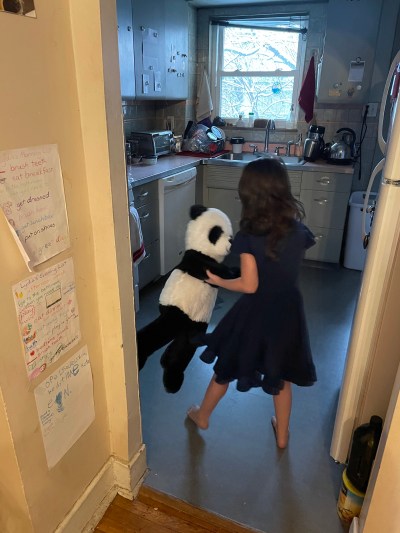
At left, you can see the Morning List and Evening List we made to organize Lydia’s routine at the beginning of kindergarten. Of course the routine has been different since school closed, but she didn’t want to take them down and added an additional document of her own, related to a paper sloth for whom she briefly took responsibility.
One of the first things I remember Lydia telling us about kindergarten was that the music teacher started class by singing each child’s name, and the child would sing back, “I’m here!” It’s been sweet to hear that roll call happening via video meeting twice a week. Overall, I’m impressed with what the music teacher has been able to teach in this format. Lydia has been learning and remembering catchy songs about musical terms like largo and arpeggio and really understanding what they mean.
For several weeks, they were studying rhythm and drumming along with a song, which is a great activity for distance learning because a family might own a drum (we have a wooden one, a toddler toy) but if not, there are lots of ways to improvise a drum, or you can just tap out the beat on a surface.
The music class right before winter break taught the kids a dance to do with a partner. Those who didn’t have a family member available could grab a doll or stuffed animal. “We all dance in a circle of light! Holding hands and smiling bright!” It got me all choked up, thinking of people who couldn’t be together in holiday celebrations at the darkest time of year . . . but when you can dance with a giant panda, on the warm linoleum in front of the heat vent, life is really not so bad, huh?
Art
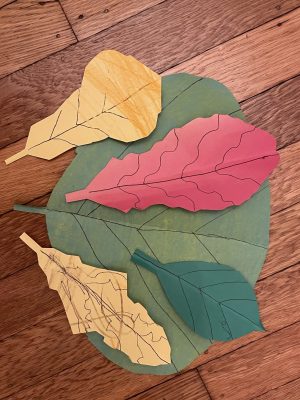 Distance learning has had to focus mostly on art projects done with crayons and ordinary paper, which most kids have at home. A few art supplies, like colored construction paper, were provided at the beginning of the school year and used in specific projects. That may be where Lydia learned how to make these nicely symmetrical autumn leaves. She then made a bunch of them and decorated our house for autumn!
Distance learning has had to focus mostly on art projects done with crayons and ordinary paper, which most kids have at home. A few art supplies, like colored construction paper, were provided at the beginning of the school year and used in specific projects. That may be where Lydia learned how to make these nicely symmetrical autumn leaves. She then made a bunch of them and decorated our house for autumn!
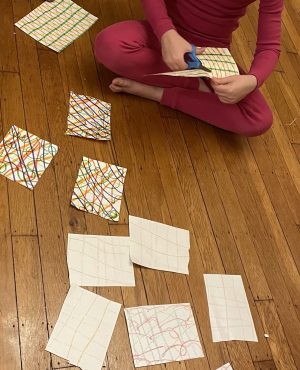 For some reason, Lydia’s attention and willingness to follow directions have been much better for pre-recorded videos than for live instruction on video chat! The art teacher has found some very effective “learn to draw” videos to share with the class, and Lydia has adopted some of the techniques to draw people, trees, and animals in different styles.
For some reason, Lydia’s attention and willingness to follow directions have been much better for pre-recorded videos than for live instruction on video chat! The art teacher has found some very effective “learn to draw” videos to share with the class, and Lydia has adopted some of the techniques to draw people, trees, and animals in different styles.
She also launches a lot of art projects on her own. At one point she drew several plaids and decided she was going to make them into a patchwork quilt. Her enthusiasm for this project propelled her into making some hastier and less colorful plaids so she could get on with piecing her quilt. Then she taped together just a few pieces before bedtime, and she never returned to the project…but it was a neat idea!
 During the winter, Lydia made some paper fish and repeatedly buried them in the snow in our yard so that she could go “ice fishing” at recess. I bet they never get to do that during in-person school!
During the winter, Lydia made some paper fish and repeatedly buried them in the snow in our yard so that she could go “ice fishing” at recess. I bet they never get to do that during in-person school!
Lydia also helped me with the very practical art project of cutting up one of her father’s old T-shirts to make handkerchiefs for his birthday. We figured out how to work around the holes and seams to make 8-inch squares; she measured and marked them by pressing with the edge of the ruler (with fabric spread out on the carpet), and I did the cutting.
Physical Education
This has been one of my favorite subjects in distance learning. The kindergarten packets included written guidance for P.E. that was surprisingly informative to this clumsy, sports-incompetent parent! Now I know when to point my fingers up vs. down to catch a ball!
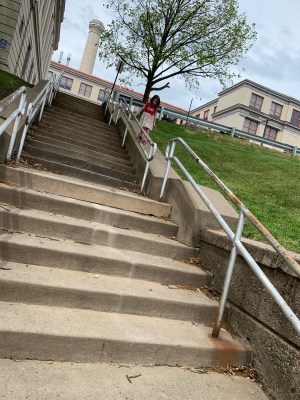 Watching Lydia practice her skills, I realized she was able to hop on one foot only if it was the right foot–on her left, she kept losing her balance. That was disturbing to see but not a serious problem, just a sign of what to practice. I started directing her to hop on her left foot anytime she was going to hop on one foot–for instance, on the hopscotch board at the playground–and she’s improved a lot.
Watching Lydia practice her skills, I realized she was able to hop on one foot only if it was the right foot–on her left, she kept losing her balance. That was disturbing to see but not a serious problem, just a sign of what to practice. I started directing her to hop on her left foot anytime she was going to hop on one foot–for instance, on the hopscotch board at the playground–and she’s improved a lot.
Even when schools were closed, gyms were closed, and all playgrounds (both schools and city parks) were barricaded with caution tape, we could use parts of the school grounds for fitness activities. Who needs a stair-climbing machine when you’ve got a huge staircase? And when the stairs themselves aren’t challenging enough, you can walk along the outside edge! The grounds of Nick’s school also include a retaining wall perfect for walking along (up to five feet above the ground!) and a large, sloping lawn where a magical cheetah/warrior cat can make valiant efforts to catch a bird.
 That’s just a few blocks from our house, but right on our own block Lydia can engage in the traditional urban child’s exercise of climbing a fire hydrant!
That’s just a few blocks from our house, but right on our own block Lydia can engage in the traditional urban child’s exercise of climbing a fire hydrant!
This school year, the kids have had live P.E. class over video chat, and Lydia’s teacher has done an outstanding job of thinking up exercises and games the kids can do with ordinary household objects! A rolled-up pair of socks can serve as a ball. Everybody has some kind of plastic cup or cardboard box to use as a basket for the ball. They’ve done scavenger-hunt races in which everyone has to find, say, a book, a shoe, and a pen and try to be the first to get back to the computer–then put everything back where they found it as quickly as possible!
My favorite activity to watch has been the obstacle course. Each first-grader sets up her own challenges using household objects, and then they take turns running the course while the others watch. It’s a fascinating glimpse into different families’ homes and every child’s inventive enthusiasm!

We’ve been introduced to a lot of kids’ fitness videos, both by links printed in the kindergarten packets and by the teacher using some videos in class. It’s easy to understand why one in which a kid kicks and stomps coronavirus particles is a favorite of Lydia’s class: Destroy the enemy, yayyy!!!
Lydia particularly likes Cosmic Kids Yoga videos, in which a British woman standing in an animated scene tells a story and demonstrates yoga poses to go along with our role in the story. One day Lydia did a Cosmic Kids Yoga during lunch break, and then a little later, her math class was interrupted by a British voice suddenly shouting, “SITTING ON YOUR BOTTOM!” It took a moment to realize that the video had started playing again in an inactive browser tab. Awkward!
Outside school hours, we have adventures in the two large parks within half a mile of our home. We get exercise, practice balance, and learn about nature and navigation, all at the same time, in places so beautiful that I’m constantly reminded how lucky we are to live here.
Foreign Languages
Lydia’s school teaches Spanish beginning in third grade–no foreign language at her level. But the district’s kindergarten packets included Spanish and Mandarin lessons for students of magnet schools where one of those languages is taught in all grades. We took that opportunity to learn some vocabulary, too! Lydia may or may not remember it, but it’s good to learn.
Last summer, I pulled out the German textbook we bought at a yard sale about 25 years ago because it was the same book both Daniel and I had used in high school. Unsere Freunde has 1970s photos and illustrations that looked hilariously outdated already in the late 1980s, but it provides clear, thematic lessons in basic German. Reviewing my vocabulary and practicing my pronunciation was good for me as well as fun for Lydia, who quickly picked up some basics. Beantwortet die Fragen! (answer the questions) is the phrase that’s stuck with her; it’s used at the top of each chapter review, and Lydia is very entertained by the idea that in German, a command always ends with an exclamation point, suggesting to us English speakers that it should be shouted.
Disney’s animated series “The Lion Guard” is of course one of Lydia’s favorites, and we found that most of the songs from the show are on YouTube and can be played over our Google Home. The rest of the family got tired of hearing them over and over, but Lydia picked up a lot of Swahili vocabulary as well as practicing her singing skills! “Sisi Ni Sawa” was a cheerful reminder of our values during last summer’s racial tensions.
…and some things never taught in school…
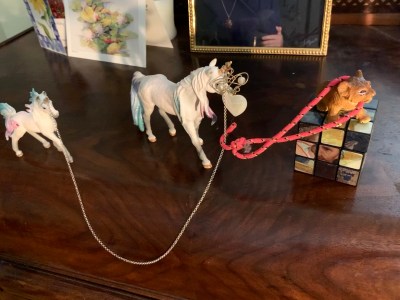 Having the kids home all the time increases their opportunities to rearrange our home environment in ways that may surprise us. Daniel and I have spent a lot of time directly engaged with Lydia, teaching her or just having fun together, but we also need her to play alone for a while so we can get other things done–and sometimes that results in scenarios we stumble upon after she’s in bed.
Having the kids home all the time increases their opportunities to rearrange our home environment in ways that may surprise us. Daniel and I have spent a lot of time directly engaged with Lydia, teaching her or just having fun together, but we also need her to play alone for a while so we can get other things done–and sometimes that results in scenarios we stumble upon after she’s in bed.
I have no idea what’s happening in this picture, but it’s clear that the cat is in charge.
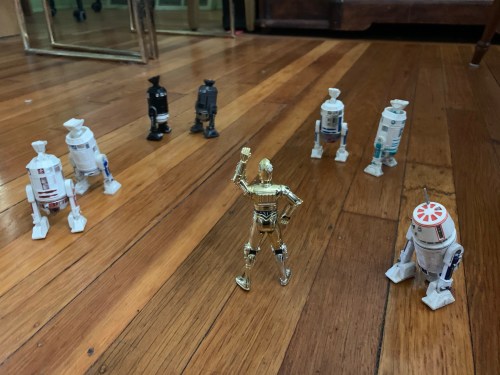 This scene (also discovered spontaneously) is obviously a gym class for droids, and C3-P0 is obviously the teacher. R5-D4 is wandering away, like he does, with his misplaced motivator.
This scene (also discovered spontaneously) is obviously a gym class for droids, and C3-P0 is obviously the teacher. R5-D4 is wandering away, like he does, with his misplaced motivator.
In her outdoor play, Lydia has used umbrellas surprisingly often as “tents” to shelter from the rain or sun. One of her first projects after school closed was setting up a camp for Sparkle Bunny (a small pink plastic toy); she learned through experimentation that she had to weight the umbrella to keep it from rolling off the porch pillar and that her watering can (half filled) was the perfect weight.
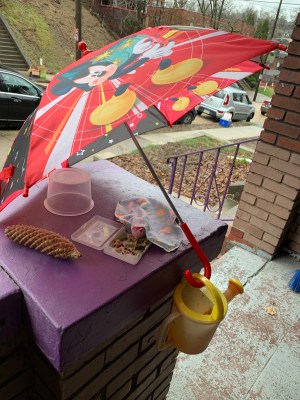

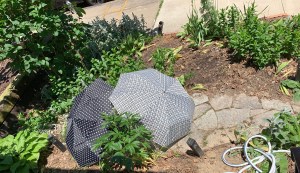
The overall experience of 2020 and 2021 has kept me thinking about the main point John Holt made in How Children Learn (a book that blew my mind) almost 60 years ago: Children, especially young ones, are learning all the time, from everything they do. Of course we can teach and help them and set up situations that encourage learning, but kids come equipped to learn from their situation and environment, whatever it may be–and we actually can get in the way of their natural learning when we try to direct it too much.
Daniel and I would have done distance learning differently if we were in charge. The hardest things for us, almost every day, have been saying over and over again, “Pay attention to the computer, not to me!” (because that’s so unnatural, basically the opposite of what we’d usually say) and simultaneously feeling irritated at how much we have to be “on duty” with our child to get her to do her schoolwork instead of misbehaving. We had been parents for 15 years before the pandemic, but we’d never had a period longer than a few weeks when it was really just the two of us managing a child 24 hours a day! These 15 months without school or babysitters, and with only a few times when Lydia could go to a park with a friend’s parent for a few hours, have been very draining!
But it’s also been wonderful to have so much time together with our little girl, watching her learn and grow. Looking back, I’m amazed at how much bigger and older-looking she’s gotten, how much her reading and thinking and coordination have improved. It’s hard to see when we’re looking after her all the time, day after day.
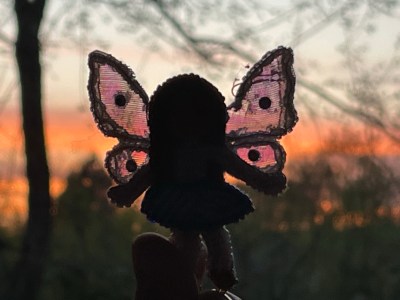 Here’s a picture Lydia must have taken with my camera when I wasn’t looking. It’s a two-inch-tall fairy doll she got at a science fiction convention in 2019, looking out her window at the sunset. This tiny fairy has been a companion on many adventures, indoors and out, and is looking a bit tattered, but at the end of the day she’s still standing strong.
Here’s a picture Lydia must have taken with my camera when I wasn’t looking. It’s a two-inch-tall fairy doll she got at a science fiction convention in 2019, looking out her window at the sunset. This tiny fairy has been a companion on many adventures, indoors and out, and is looking a bit tattered, but at the end of the day she’s still standing strong.
What a long, strange year it’s been! I hope and pray that this chapter is drawing to a close and we’re moving into a safer, wonderful future–but let’s not be too quick to forget this time. Let it be a source of great stories our kids will tell all the rest of their lives!
My hope for the schools is that they’ll be able to go “back to normal” this autumn but also realize that nobody can pretend the unusual circumstances of the past two school years made no difference. I hope every teacher will realize that, although many students missed some of the things they “should have” learned in the past two grades, everybody has learned something, and when they come back together, they can teach each other what they’ve learned, and they’ll all learn something new.
Visit Hearth & Soul and Friendship Friday to read other writers’ thoughts on life in 2021!
A fantastic report on the year–very complete and compelling.
Love, Jay
I would never send any child to what has become, in recent decades, far more today, as propaganda camps.
I’ve spent a full school year overhearing what our local school teaches to first-graders, and I have no objections to any “propaganda.”
Johnny Appleseed: We share, then let people listen to reason, or not. Those who have been propagandized, knowingly or unwittingly (The second is out of wrong motivation.), think propaganda is reality. All propaganda is is rewriting what we all know intuitively, putting one’s dishonesty over what is best for others. For instance, I would never tell anyone that college is the path to success. I would encourage people to make their own decisions, placing family and doing what’s right first, and within that, make their own responsible decisions, trusting in themselves and what they know intuitively. Not arrogantly. We’re all born knowing the difference between right and wrong and parents are the guardians from the world of propaganda, rhetoric, and crime.
The best way to teach children to resist propaganda is not to shelter them from ever hearing it but to teach them how to recognize illogical or manipulative arguments. My teenager is really good at that now, and my first grader is working on it.
I so enjoyed this article and I can relate to almost every single bit of it as we were in a position where we could keep our first-grader home this year as well. And I laughed out loud when I read what you wrote about others who seem to think that having kept a child home meant literally staying inside all the time with no interaction with others–we encountered this too!
I feel so fortunate to have been able to witness my son’s learning this past year. When nurtured and valued, a child’s desire to learn can be an unstoppable force.
Pingback: Forgotten Secret Darkest Midnight Book Reviews | The Earthling's Handbook
The difficulty in teaching others how to resist propaganda is each person acknowledging what is real, right, and correct. We all come into the world knowing what is right. Parents (good) are the example and protect.
Pingback: Three Weeks of Mostly Vegetarian Dinners (winter, in a pandemic) | The Earthling's Handbook
Pingback: What Might Get You Through 2022 | The Earthling's Handbook